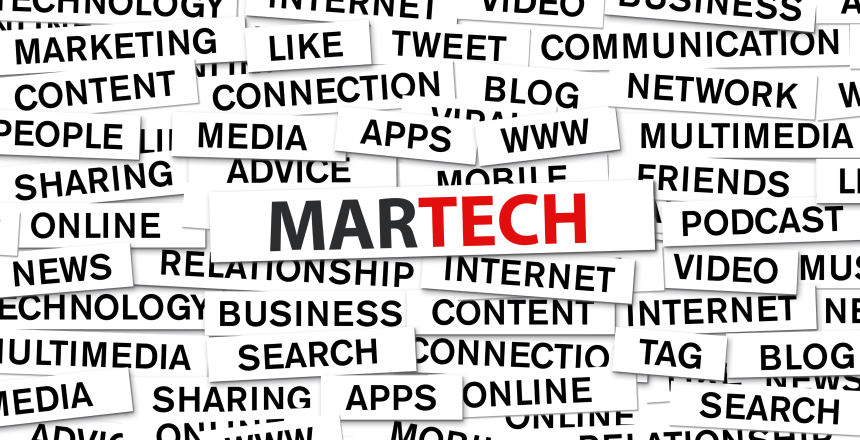Business departments do not exist in a vacuum. They collaborate with other departments to make design processes easier and to get the best results. And no department collaborates more than marketing.
Why?
Because as marketing becomes more technology-oriented, tech and marketing departments can work together to improve customer experiences. As a result, the combination of marketing and technology or MarTech is being used by businesses to ensure customer success.
MarTech also helps companies experience the best of marketing and technology at the same time. The question is: how is MarTech doing that? Let’s find out.

What is MarTech?
Marketing technology, commonly known as MarTech, describes a range of tools and software used to accomplish sales & marketing (a.k.a Revenue Growth) objectives and goals. When a business utilises a marketing technology group, it is referred to as a marketing technology stack.
MarTech has become the new norm in Revenue Growth campaigns and is used to streamline the associated efforts across any channel.
What technologies are part of MarTech?
Tools that combines sales & marketing and technology comes under the umbrella of MarTech. I went into more detail in my August article titled, ‘Tech Meet Marketing, Marketing Meet Tech’. Let’s dig in to some of the common MarTech tools:
1. Customer Relationship Management (CRM) software
CRM software helps align and sales & marketing is commonly used by B2B businesses but also B2C, too. It ensures marketers and sales reps have access to customer data, helping them manage relationships as they grow.
CRM software also allows organisations provide better customer service, increase customer retention and need anticipation, manage all interactions with prospects in one place, and help identify and convert more leads.
2. Content marketing systems
A content marketing system (CMS) is used to manage your website. It’s a crucial part of your business because it helps you increase your reach, identify more leads, and enhance customer retention.
A CMS also allows you to create, publish, and refresh content when needed. For example, you can create social media posts, Twitter threads, blog posts, videos, and even infographics using a CMS.
So, investing in a CMS is essential to managing your marketing needs and increasing your business reach.
3. Email marketing platforms
Email remains an integral aspect of stacks and strategies. It allows marketers to communicate between each tool in their MarTech stack.
Data analysis with email automation makes for the best combination in today’s marketing environment. It allows businesses to send out highly targeted campaigns that improve retention rates.
It is pretty standard for email marketing platforms to have inbound market solutions today. These help businesses increase their exposure and conversion rates, ensuring a greater ROI.
4. AdTech
Advertising Tech or AdTech is a form of MarTech and relates to managing digital campaigns. It allows you to serve targeted ads to your preferred audience.
You can also measure the success of campaigns by tracking clicks and engagement levels. This information can also be used to set up the direction of future campaigns.
Using a platform that tracks data and focuses on which ads worked and which didn’t can help you optimise your budget for spending ads and turn your prospects into leads.
5. Social media management platforms
Social media is a crucial part of engagement for modern businesses. It is a must-have for tech businesses.
Plus, social media platforms are beneficial for your content strategy. They help you manage customer queries, analyse engagement levels, and increase website traffic, as well as details on how effective your interactions are with users.
6. Search Engine Optimisation (SEO) tools
SEO tools allow businesses to evaluate the best strategy for ranking their content on search engines like Google. SEO is crucial for increasing your reach, conversion levels, user engagement, and customer retention.
SEO also helps you market your products or services to a broader audience. You can read more about the relevance of SEO in 2022, here.
What skills do you need to make MarTech work?
A MarTech stack is complex to manage. So, you need specific skills to make it work. Here are some MarTech-facing skills you need to have:
1. Understanding MarTech integration
A MarTech stack combines systems that ensure business departments work in harmony with each other. It allows marketers to use specialised tools to gain insights into their customer base, traffic, and user needs.
To create a MarTech stack that runs smoothly, you need to ask yourself the following questions:
- Do all applications have an intended purpose?
- Can all applications perform the same job as other applications?
- Can you replicate tasks carried out by another application?
When you use several platforms, successful integration becomes crucial if you want accurate data. To achieve that, you can use APIs to make connections between programs and ensure they transfer accurate data.
2. Understanding the difference between AdTech and MarTech
Before jumping onto the MarTech bandwagon, it’s essential to know the difference between MarTech and AdTech.
AdTech is the combination of Advertising & Technology. The technology helps with online display, retargeting, and programming ads. It’s about serving and creating advertising opportunities for potential customers through digital channels. AdTech solutions include:
- Data Management Platforms (DMPs) enable you to store 3rd-party cookie data. However, DMPs are becoming less relevant due to the changes in cookie tracking requirements.
- Demand Side Platforms (DSP) let you choose targeting criteria based on location, demographics, device, browser, etc.
- Ad Servers and Ad Exchanges allow you to display video advertisements across relevant websites.
In contrast, MarTech is about content delivery and providing the best customer experience. Here’s an example of a MarTech stack:
- A CRM platform that records customer contact information data and purchase history.
- A marketing automation software that’s used to perform, create, and manage marketing campaigns. Some examples include Oracle Marketing Cloud and IBM Marketing Cloud.
- An analytics package like Google Analytics helps you measure the traffic coming to your website.
3. Data Integration, Accessibility & Insights
With so many options in the MarTech landscape, data management needs to be a fundamental part of any successful marketing technology plan. However, accessible data volumes have been increasing in the past years, making it challenging for marketers to gain insights from the data collected.
Having a data first mentality will help marketers navigate this issue. This approach allow you to feed data into a single system, helping you conduct a more comprehensive data analysis that aids you in making informed business decisions.

Would you like to learn more about how MarTech can reduce those repetitive tasks and help your business compete, better? Dovetail Group can help. Start a conversation.
At Dovetail Group, we provide simple, yet effective revenue growth services and solutions to make everything work well.
Interested in learning more? Start a Conversation.


